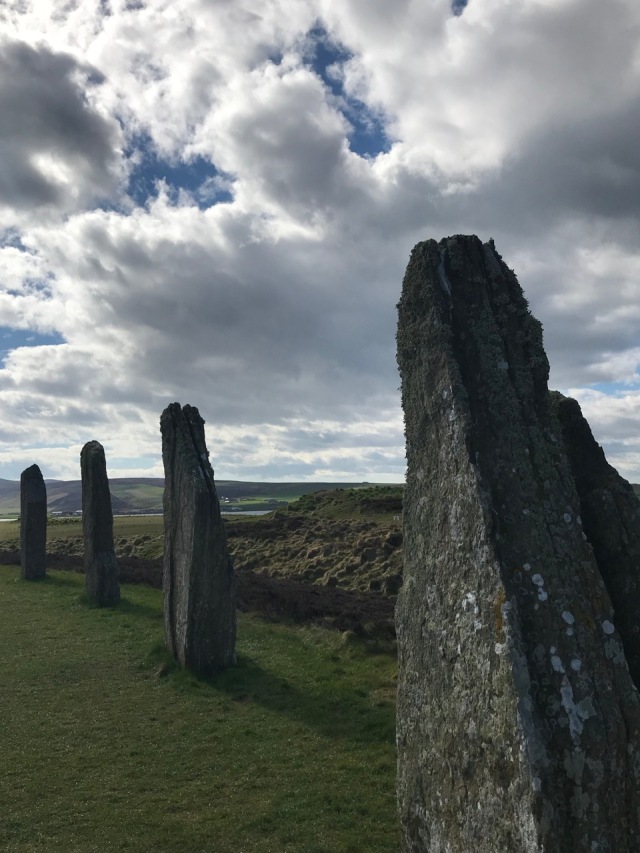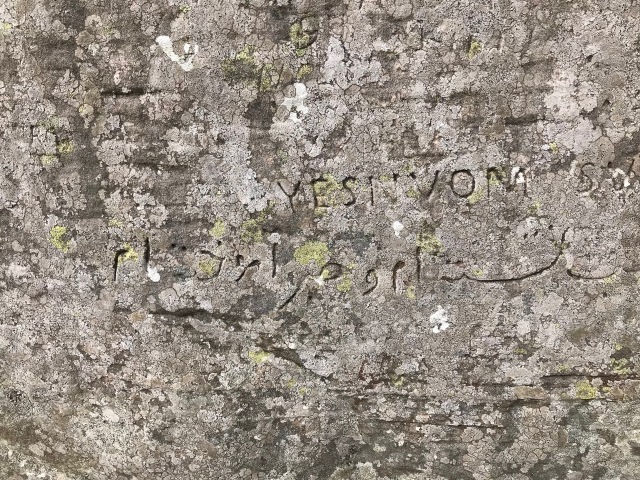You turn to take in the landscape… This magnificent place, where the natural features are as spectacular as the Neolithic discoveries, lies between two lochs surrounded by a natural amphitheatre. You are encircled by the hills and the monuments that make up the heart of Orkney’s Neolithic World Heritage Site. Welcome to the Ring of Brodgar, in the valley of the stars…
(1500 words, a twelve-minute read)
The Ring of Brodgar lies on the isthmus between the Lochs of Harray and Stenness. It is one of the best stone circles in the world and originally comprised 60 megaliths, of which 27 remain upright. It is a perfect circle, 104 metres in diameter.
It is breathtaking, and unlike many ancient circles, if you go at the right time, you can have it all to yourself… When we visited, in September 2020, there were less than twenty people there.

It used to be that theories of Neolithic Orkney were based around the Brodgar stone circle, but now, an entire complex of temples and dwellings, located just a few hundred metres away, have been added to the list of treasures to be found here. The Ring of Brodgar is likely to remain the central attraction, but with Skara Brae within a day’s return walking distance and the new discoveries matching the latter in style, the entire Ness of Brodgar is now being seen as a ‘spiritual city’, rather than just the place of the stone circle.

I’m fortunate in that I’ve been here twice. I’ve documented many of our explorations of Scottish islands in these pages.
In May 2018, we fulfilled a life-ambition and, came to Orkney for a five-night spring break, travelling with some friends by train to Thurso, then by ferry across to Orkney – as with this present Silent Eye trip. Bernie had spotted, online, that there was a local pagan group who would be celebrating the Beltane festival at the stones. They had invited anyone interested to join them, asking for a few details prior to our arrival.
I count myself more a mystic than anything else, and wrote to tell them that, but they were pleased to have us present, and, in view of my personal history, offered me a small part in the ceremonial proceedings. It was a great honour.

(Above: from May 2018 – the Beltane ceremony)
This was on our second evening, and we hadn’t yet collected our rental car, so we took a taxi from Stromness to the Comet Stone, which marks the beginning of the Brodgar site. From there, we were inducted into the ceremonial process. It was a lovely event, with an open spirit and a celebration of the magnificence of the location and its importance to Orkney – past and present.
I will remember it most for the sunset. It was early May and we had expected little in the way of decent weather. But Orkney surprised us with the most golden sunset I have ever seen. Even after leaving the site, standing at the bus stop a mile away, we were still gazing mutely at the sky, enraptured that this could have happened.

The Orkney weather on the 2020 trip was overcast, so I have included shots from both visits to give the reader a flavour of that splendour in this most powerful of locations.
The Ring of Brodgar is a Neolithic henge and stone circle. It is rare to find both in the same site. It is the only stone circle in Britain which is a perfect circle. Brodgar ranks with Avebury and Stonehenge as among the greatest of such sites. These are the northernmost examples of circle henges in Britain.

(Above: Ring of Brodgar – September 2020)
There are no known stones within the circle (unlike Avebury, for example) but there has never been a detailed excavation of Brodgar, and wooden structures may have been located within. The Ring of Brodgar was created later than most of the surrounding sites, such as the chambered mound of Meashowe and the nearby settlement of Skara Brae. It is likely that it represented the pinnacle of the work of these mysterious people, who may well have been the forerunners of the Picts.
The Ring of Brodgar is managed by Historic Environment Scotland, whose ‘Statement of Significance’ for the site describes its significance better than I could:
The monuments at the heart of Neolithic Orkney and Skara Brae proclaim the triumphs of the human spirit in early ages and isolated places. They were approximately contemporary with the mastabas of the archaic period of Egypt (first and second dynasties), the brick temples of Sumeria, and the first cities of the Harappa culture in India, and a century or two earlier than the Golden Age of China. Unusually fine for their early date, and with a remarkably rich survival of evidence, these sites stand as a visible symbol of the achievements of early peoples away from the traditional centres of civilisation…The Ring of Brodgar is the finest known truly circular late Neolithic or early Bronze Age stone ring and a later expression of the spirit which gave rise to Maeshowe, Stenness and Skara Brae’
(Quoted from Wikkipedia)
The Ring of Brodgar’s natural setting did not function alone. There is a final addition to the story of Brodgar’s sacred landscape. The mapping of the heavens carried out by the ancient priests required they mark the position of the winter solstice sunset… ideally against a feature on a hill in the landscape, as used throughout the Scottish Pictish world.

(Above: The Brodgar stone marking the winter solstice setting sun points to a valley on the neighbouring island of Hoy)
The chosen position (above) – a valley between two mountains – looks close to Brodgar, but is in fact on the neighbouring island of Hoy. A mysterious shrine, now known as the ‘Dwarfie Stane’ was constructed at the exact spot on Hoy corresponding to this line of sight from the Ring of Brodgar.

(Above: the mysterious Dwarfie Stane on the island of Hoy)
The information board at the Dwarfie Stane reads:
Dwarfie Stane
This unique monument has attracted attention for centuries and many scholars have visited it and theorised. It has been described as the dwelling place of giants, of dwarves, and as the home of an early Christian hermit.
It was actually a tomb, related to the many chambered cairns found throughout Orkney. It dates to between 3500 and 2500 BC. Its construction, carved from a single enormous block of stone, is without parallel in the British Isles.
The labour involved, given the lack of metal tools, suggests that although small, it may have been of special significance.’
During the 2020 workshop, we did not have time to visit Hoy. But we were fortunate to have stumbled across it on our 2018 personal trip, during which we had visited the neighbouring island. Then, we had no knowledge of the link between Brodgar and the mysterious ‘natural shrine’ we came across on our way to the far side of that mainly uninhabited island.

(Above: from 2018 – Hoy’s dramatic west coast – the Old Man of Hoy is an hour’s walk from here)

(Above: Hoy is beautiful but bleak)

(Above: from 2018, the Dwarfie Stane looks back towards the Ring of Brodgar – lone sentinel of the winter solstice sun)
We took away some wonderful memories of that earlier trip to Hoy. Two stand out in memory. The first was a Persian inscription on the walls of the ‘Dwarfie Stane’, left by a Victorian artist, soldier and traveller, Willam Mounsey. On the outer wall of the tomb, he wrote ‘I have sat for two nights and have found patience’. To me, this immediately suggested a Sufi thought.

No-one knows what its meaning is. But Mounsey was a learned scholar who could speak and write in several middle eastern languages, including Persian and Hebrew. He is believed to have operated as a spy for the British Army. He was an accomplished historian and an authority on the Celts. His work suggests to me that he had a ‘mystical bent’. It’s entirely fanciful, but I like to think he may have sat there, looking back along the line of sight to Brodgar and musing about the spiritual nature of the Celts who created this ‘line of light’.
The second memory is of a startled Bernie seeing a golden eagle minutes later, in the telescope of a bird-watcher parked in the lay-by. He had been watching the eagle on its nest for many hours and offered us each a viewing. Only Bernie saw it… but what an end to the day it had provided.
At the time, we knew nothing of the visual link across Scapa Flow to the Ring of Brodgar, but, now, two years later and standing at the Brodgar marker stone, looking across at Hoy and remembering, I marvelled at how connected our human experience can be…
In the next post we will look at the remaining sites at or near to the Ness of Brodgar and summarise the incredible story of this heart of Sacred Neolithic Orkney.
To be continued.
Notes:
Link to William Mounsey.
Other parts in this series:
Part One, Part Two, Part Three, This is Part Four.
The preceding Pictish Trail weekend blog posts:
Part One, Part Two, Part Three, Part Four, Part Five, Part Six, Part Seven, Part Eight, Part Nine
©Stephen Tanham, 2020.
Stephen Tanham is a Director of the Silent Eye – a journey through the forest of personality to the sunrise of Being.


Reblogged this on Sue Vincent's Daily Echo.
Thank you, Sue x
Reblogged this on firefly465 and commented:
The Silent Eye and The Ring of Brodgar
Thank you, Adele. Glad you liked it!
This brought back some great memories of our trip last year. We walked around the Ring in October 2019 and saw only 2 other people there. Maybe that had something to do with the fact it was raining hard, but hey, you don’t go to Orkney for the weather, do you? A truly magical trip.
A wonderful place, Deborah. I’d go back… and back, again…
I plan on it.
Reblogged this on Have We Had Help? and commented:
Thr Ring of Brogar anyone?
Thank you, Jack.
My pleasure Steve. It’s part of the world I’d love to visit…
Do it while you can… I put it off for far too long!
Health wise I’m not up to it…
Then we’ll try to be your magic carpet!